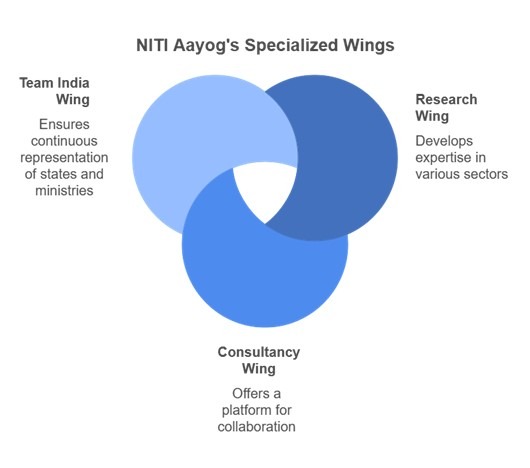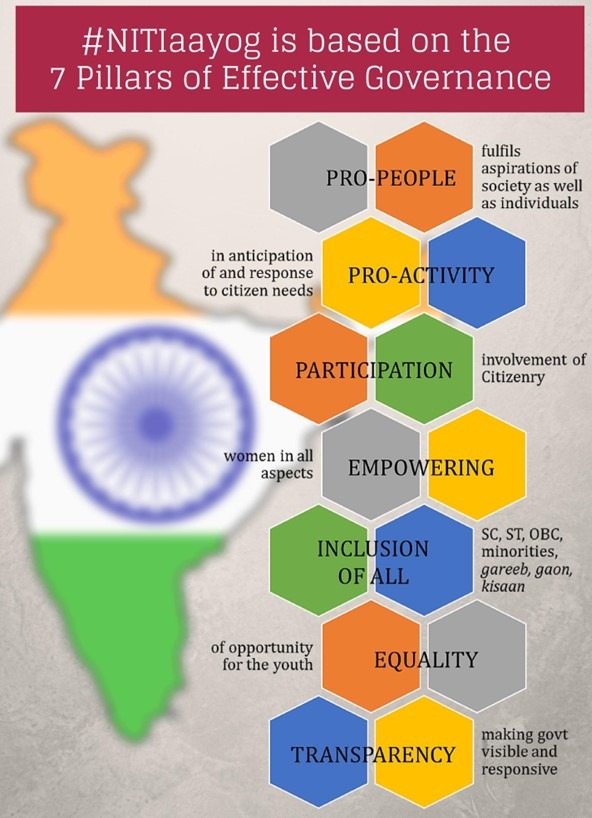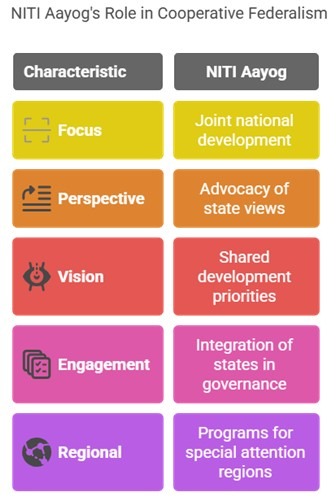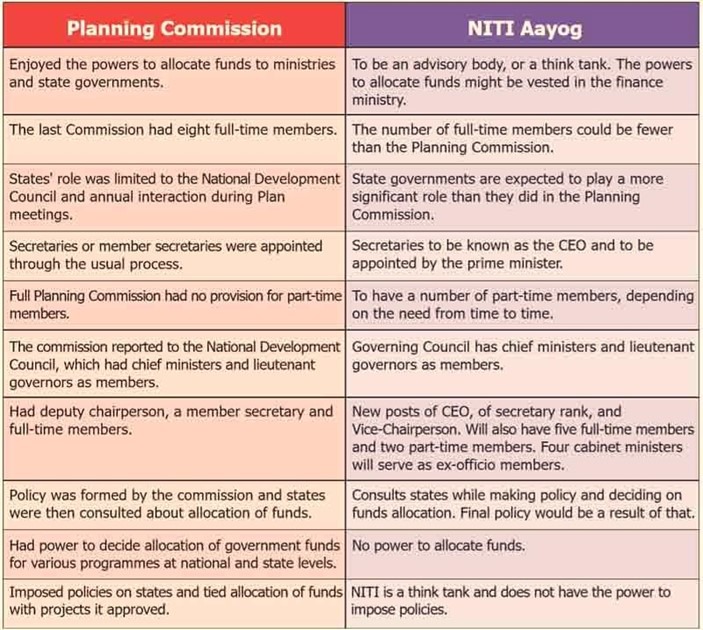NITI Aayog
NITI Aayog: Composition and Objectives
NITI Aayog (National Institution for Transforming India) was established as a replacement for the Planning Commission, aimed at fostering cooperative federalism and inclusive development in India. Below are the details regarding its composition, objectives, and the roles it plays in the governance and development framework of the country.
Composition of NITI Aayog
The structure of NITI Aayog comprises several key members and bodies:
1. Chairperson:
- The Prime Minister of India serves as the Chairperson of the NITI Aayog.
2. Governing Council:
- This consists of the Chief Ministers of all States and the Chief Ministers of Union Territories with Legislatures (Delhi, Puducherry, and Jammu and Kashmir). The Lieutenant Governors of the Union Territories without Legislatures are also included.
3. Regional Councils:
- These councils are formed to address specific issues affecting multiple states or regions and are convened by the Prime Minister. They include Chief Ministers and Lieutenant Governors from the respective region and are chaired by the Chairperson of the NITI Aayog or their nominee.
4. Special Invitees:
- Experts, specialists, and practitioners with relevant domain knowledge can be invited as special invitees by the Prime Minister.
Full-time Organizational Framework:
- Vice-Chairperson: Appointed by the Prime Minister, enjoying the rank of a Cabinet Minister.
- Full-time Members: Appointed members who hold the rank of Minister of State.
- Part-time Members: A maximum of 2 members who are from leading universities or research organizations. These may be on a rotating basis.
- Ex-Officio Members: Up to 4 members of the Union Council of Ministers nominated by the Prime Minister.
- Chief Executive Officer: Appointed by the Prime Minister for a fixed term, holding the rank of Secretary to the Government of India.
- Secretariat: As deemed necessary for the functioning of the Aayog.
Specialized Wings
NITI Aayog has specialized wings to enhance its effectiveness:
- Research Wing: Develops expertise in various sectors as a think tank for policy formulation.
- Consultancy Wing: Offers a platform for collaboration, matching government needs with solution providers.
- Team India Wing: Ensures continuous representation of states and ministries, facilitating communication for development-related matters.
Objectives of NITI Aayog
The NITI Aayog’s overarching objectives are designed to align with India’s developmental needs, focusing on inclusive growth and effective governance:
1. Shared Vision:
- Evolve a common vision for national development priorities and strategies, actively involving states.
2. Cooperative Federalism:
- Foster a cooperative framework by engaging states through structured support initiatives.
3. Local Planning:
- Develop mechanisms for formulating actionable plans starting at the village level, progressively aggregating them up the governmental hierarchy.
4. National Security Consideration:
- Ensure that national security interests are reflected in economic strategies and policies.
5. Support Underserved Sections:
- Pay special attention to marginalized sections of society that may not fully benefit from economic progress.
6. Long-term Policy Frameworks:
- Design strategic and long-term policies, monitor their efficacy, and make necessary adjustments based on feedback.
7. Collaboration with Stakeholders:
- Encourage partnerships with national and international think tanks and research institutions.
8. Knowledge and Innovation Support:
- Create an ecosystem fostering innovation and entrepreneurial support in collaboration with experts and practitioners.
9. Cross-Sectoral Resolution Platform:
- Provide a space for addressing inter-sectoral issues to accelerate development agendas.
10. Resource Center:
- Maintain a resource center to serve as a repository of research on good governance and sustainable development practices.
11. Monitoring and Evaluation:
- Actively monitor the implementation of programs to enhance their effectiveness and success rates.
12. Focus on Capacity Building:
- Promote technology upgradation and capacity building for effective program implementation.
NITI Aayog operates as a pivotal institution in India’s governance landscape, shifting the focus from a central command-and-control approach to a cooperative and inclusive federalism model. By actively engaging states and emphasizing collaborative planning and implementation mechanisms, NITI Aayog aims to address the diverse challenges of development while ensuring that all sections of society benefit from economic progress. Its establishment marks a significant evolution in the framework of national planning, aiming for a more responsive and accountable governance structure.
Functions of NITI Aayog
The NITI Aayog has a multidimensional role focused on facilitating national development through cooperative federalism, strategic policy-making, and innovative solutions. Its functions can be categorized into four main areas:
1. Design Policy and Programme Framework:
- NITI Aayog formulates strategic policies and frameworks aligned with national development goals and priorities. It works to ensure that policies are effectively tailored to varying state contexts.
2. Foster Cooperative Federalism:
- The Aayog aims to promote a cooperative framework between the Central and State governments, moving from a historically top-down approach of governance to a more collaborative environment where states have a voice in shaping policies that affect them.
3. Monitoring and Evaluation:
- NITI Aayog monitors the implementation of various policies and programs, assessing their effectiveness and making necessary adjustments based on empirical evidence and feedback.
4. Think-tank, Knowledge and Innovation Hub:
- The Aayog serves as a knowledge and innovation hub that synthesizes information from various sources, aiding in decision-making by providing data-driven insights and recommendations.
Organizational Structure and Verticals
To effectively carry out its mandate, NITI Aayog is structured into various Verticals, each focusing on specific sectoral issues and priorities for national development. The key Verticals include:
- Agriculture
- Data Management & Analysis
- Energy
- Financial Resources
- Governance & Research
- Governing Council Secretariat
- Health
- Human Resource Development
- Industry
- Infrastructure Connectivity
- Land & Water Resources
- Managing Urbanization
- Natural Resources & Environment
- NGO Darpan
- Project Appraisal & Management Division (PAMD)
- Public-Private Partnerships
- Rural Development
- Science & Technology
- Skill Development & Employment
- Social Justice & Empowerment
- State Coordination and Decentralized Planning
- Sustainable Development Goals
- Voluntary Action Cell
- Women & Child Development
Guiding Principles
NITI Aayog operates under several guiding principles that shape its approach to development:
1. Antyodaya:
- Emphasizing the upliftment of the poor and marginalized, reflecting the philosophy of Pandit Deendayal Upadhyay.
2. Inclusion:
- Empowering vulnerable sections and addressing all forms of identity-based inequalities, such as gender, region, caste, and class.
3. Village Integration:
- Engaging villages in the development process to leverage local culture and vitality.
4. Demographic Dividend:
- Harnessing India’s population by focusing on education, skill development, and creating productive livelihood opportunities.
5. People’s Participation:
- Promoting a citizen-driven approach to development, enhancing engagement in governance processes.
6. Good Governance:
- Advocating for a style of governance that is open, transparent, accountable, and purpose-driven, transitioning focus from outlay to outcomes.
7. Sustainability:
- Ensuring that environmental sustainability remains a core consideration in planning and development initiatives.
Pillars of Effective Governance
NITI Aayog seeks to establish its foundation on the following seven pillars of effective governance:
- Pro-people Agenda: Prioritizing the aspirations of both society and individuals.
- Proactive Governance: Anticipating and responding to citizen needs.
- Participative Governance: Engaging citizens in decision-making processes.
- Women’s Empowerment: Integrating women’s needs and contributions in all areas.
- Inclusion: Ensuring equitable participation of Scheduled Castes, Scheduled Tribes, Other Backward Classes, and minorities.
- Youth Opportunities: Providing equality of opportunity for young people.
- Transparency: Using technology to enhance visibility and accountability of government actions.
NITI Aayog is instrumental in shaping India’s development narrative through a focus on cooperative federalism, strategic planning, and inclusive growth. By leveraging its verticals and adhering to guiding principles, the Aayog aims to foster a dynamic governance framework that addresses the diverse and evolving needs of the nation. This approach enhances the capability of the government to respond effectively to the multifaceted challenges faced by India today.
Role in Cooperative Federalism
1. Joint Focus on National Development:
- NITI Aayog aims to align the national development agenda through active cooperation between the Central and State governments. This collaborative approach seeks to ensure that states are equal partners in development planning.
2. Advocacy of State Perspectives:
- The Aayog encourages the representation of state perspectives in discussions and decisions made by Central ministries, fostering a more inclusive governance process.
3. Shared Vision of Development:
- NITI Aayog is tasked with evolving a shared vision of national priorities, reflecting the aspirations of states in the planning process. This shift aims to move from a top-down approach to one that acknowledges the diverse contexts of individual states.
4. Engagement Initiatives:
- The Aayog undertakes initiatives aimed at integrating states into governance, such as:
- Meetings of the Governing Council: Regular meetings bring together the Prime Minister and Chief Ministers to discuss cooperative frameworks.
- Sub-groups and Task Forces: Focused on various thematic issues to foster collaboration and address specific challenges faced by states.
- NITI Forum for North East: Dedicated to addressing the unique developmental needs of the northeastern states.
- Development Support Services: Initiatives like SATH aimed at enhancing social development metrics.
- The Aayog undertakes initiatives aimed at integrating states into governance, such as:
5. Regional Focus:
- NITI Aayog has specific programs targeting regions requiring special attention, including the North Eastern states, island states, and hilly Himalayan regions.
Criticisms of NITI Aayog
Despite its objectives, NITI Aayog has faced criticism from various political leaders and opposition parties:
1. Perception of Gimmickry:
- Critics argue that renaming the Planning Commission to NITI Aayog is mere “fluff” and lacks substantive change. They question whether this rebranding serves meaningful governance or is just cosmetic.
2. Concerns Over Centralization:
- Some opposition leaders, like CPI(M) leader Sitaram Yechury, expressed concerns that NITI Aayog might lead to an environment where corporations influence policymaking, potentially causing discrimination against smaller states or marginalized communities.
3. Diminished Planning Functionality:
- Detractors believe that dismantling the Planning Commission undermines planning processes. Critics have claimed that the new structure may not effectively address developmental issues faced by states.
4. Emphasis on Market Economy:
- Some, such as Veteran CPI leader Gurudas Dasgupta, fear that the shift indicates a move towards an unregulated market economy, opposing the structured planning that was inherent in the Planning Commission’s model.
5. Call for More Effective Structures:
- Critics suggest that rather than abolishing the Planning Commission, the government should have reinforced existing frameworks like the National Development Council to enhance planning efficacy.
NITI Aayog represents a significant shift in India’s approach to governance and planning, emphasizing cooperation and partnership between the Centre and states. While its establishment is intended to enhance cooperative federalism, the criticisms highlight concerns about the effectiveness of this new structure in achieving its goals. Moving forward, the success of NITI Aayog will depend on its ability to genuinely engage states and achieve collaborative policy development that addresses the diverse needs of India’s regions.
Erstwhile Planning Commission
The Planning Commission was established in March 1950 as a non-constitutional and non-statutory body intended for economic planning and policy-making.
Functions of the Planning Commission
1. Resource Assessment:
- Assess the country’s material, capital, and human resources and identify ways to augment them.
2. Formulating Balanced Plans:
- Create plans for the effective utilization of resources and determine implementation priorities.
3. Evaluating Development:
- Regularly review progress towards plan execution and recommend adjustments as necessary.
4. Advisory Role:
- Act in an advisory capacity to both central and state governments on planning-related matters.
Critical Evaluation of the Planning Commission
The Planning Commission faced criticism for its operations and approach:
1. Perceived as a “Super Cabinet”:
- Critics described it as a “Parallel Cabinet” due to its significant influence over governmental planning and decision-making, overshadowing the Cabinet’s role.
2. Overlapping Responsibilities:
- Experts pointed out overlaps between the functions of the Planning Commission and other bodies, such as the Finance Commission.
3. Lack of Representation:
- The Planning Commission was criticized for being a center-constituted body without adequate representation from state governments.
National Development Council (NDC)
- The National Development Council (NDC) was established in August 1952 as a key advisory body for planning in India. It was created to facilitate cooperation between the Central and State governments in executing national developmental plans.
- Establishment and Context
- The NDC was founded on the recommendations of the First Five Year Plan, aiming to secure state cooperation in Plan execution.
- It operates as an executive body and is neither a constitutional nor a statutory organization, similar to the erstwhile Planning Commission.
Composition
- The NDC is composed of the following members:
- Chairperson: The Prime Minister of India.
- Union Cabinet Ministers: All Union Cabinet Ministers are members.
- Chief Ministers: All Chief Ministers of the states.
- Union Territories: Chief Ministers or Administrators of Union Territories.
Objectives
The NDC was established to achieve several key objectives:
- State Cooperation: To ensure collaboration among states in executing national plans.
- Mobilization of Resources: To strengthen and mobilize resources and efforts across the nation in support of planning.
- Common Economic Policies: To promote uniform economic policies across vital areas.
- Balanced Development: To achieve balanced and rapid development throughout the country.
Functions: To fulfill its objectives, the NDC performs several important
Functions:
- Guidelines for National Plan: Prescribing guidelines for the preparation of the national plan.
- Assessment of National Plan: Considering and reviewing the national Plan prepared by the Planning Commission (now NITI Aayog).
- Resource Assessment: Assessing the resources required for implementing the plan and suggesting measures for augmentation.
- Social and Economic Policy: Discussing important questions of social and economic policy affecting national development.
- Plan Review: Reviewing the progress of the national plan periodically.
- Recommendation of Measures: Recommending measures to achieve the aims and targets set out in the national plan.
The draft of the Five-Year Plan, prepared by the Planning Commission (now NITI Aayog), is first submitted to the Union Cabinet for approval and is subsequently placed before the NDC for its acceptance. Once approved, it is presented to Parliament and, following its approval, becomes the official plan.
Critical Evaluation
The NDC has played a significant role as a link between the Central and State Governments, facilitating coordination in planning. It has been recognized for its contributions as follows:
- Bridge between Governments: Serving as a critical connection point between the Central Government, State Governments, and the Planning Commission (NITI Aayog), which fosters coordination in developing policies and programs.
- Forum for Deliberation: Acting as a platform for discussions on matters of national importance, enabling shared responsibility and insights between different levels of government.
Difference between Planning commission and NITI Aayog
Points of Criticism
Despite its intention, the NDC has faced criticism regarding its efficacy:
1. Super Cabinet vs. Rubber Stamp:
- While some describe the NDC as a “Super Cabinet” due to its influential composition, others criticize it for being a “rubber stamp” for decisions already made by the Union government, especially during periods of Congress dominance.
2. Emergence of Regional Parties:
- The rise of regional political parties has led to a gradual strengthening of the NDC’s federal character, offering states a more significant voice in the national planning process.
The National Development Council has been an essential component in India’s planning mechanisms, fostering cooperation and dialogue between the Central and State governments. While it addresses many critical areas in national development, ongoing critiques of its role reflect the need for a dynamic and effective framework that genuinely incorporates diverse state perspectives into the national agenda. As India continues to evolve, the NDC’s capabilities in facilitating broader representation and collaboration will be crucial for achieving inclusive development.











